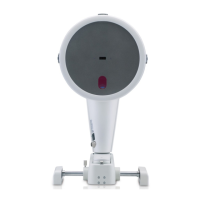13
4 Recommended settings and color maps, displays and values
4.2 Recommended color maps, displays and values
4.2.1 Screening for corneal refractive surgery
We recommend using the following maps and analysis displays:
Fast Screening Report to check whether the displayed parameters are within normal limits
4 Maps Refractive to check the pachymetry, topography and elevation maps of both corneal
surfaces
Belin/Ambrósio Enhanced Ectasia Display to check whether there deviations from normal limits
which can be a sign of early ectatic changesor keratoconus
Zernike Analysis to see whether the LOA or HOA are withon normal limits
Important values: R flat and R steep, asti and axis, Q-value, QS, pachymetry at thinnest spot and
pupil centers, distance between the corneal apex and thinnest spot. In the elevation maps please
use the parameters recommended in chapter 10.1.2
4.2.2 Pre-op screening for iris fixated phakic IOL implantation
We recommend using the following maps and analysis displays:
The 3D pIOL Simulation Software and Aging Prediction prior to iris fixated pIOL implantation
(available in the Pentacam® HR only). Calculate the required pIOL power using the implanted
calculator. Use the database to find a pIOL that best matches the patient’s subjective refraction.
Its fit in the anterior chamber is simulated in 3D and the minimum clearances are displayed. The
aging simulation allows a simulation of the pIOL position in up to 30 years. Double-check your
calculations and evaluations with the manufacturer of the respective pIOL
For all further pIOL e.g. Intraocular Contact Lens (ICL): Scheimpflug images to obtain information
on the dimensions of the anterior chamber, the iris curve and the densitometry of the cornea and
crystal lens. The view of the anterior chamber angle (ACA) shows whether there is an open or
closed angle
Evaluate the horizontal corneal diameter (HWTW). It is displayed automatically if the new iris
camera optic is built in. If not it can be measured manually in the Scheimpflug image at the 180°
position (horizontal)
Important values: R flat and R steep, asti and axis, HWTW, Q-value, QS, anterior chamber depth
(ACD) pachymetry in the thinnest spot and in the pupil center

